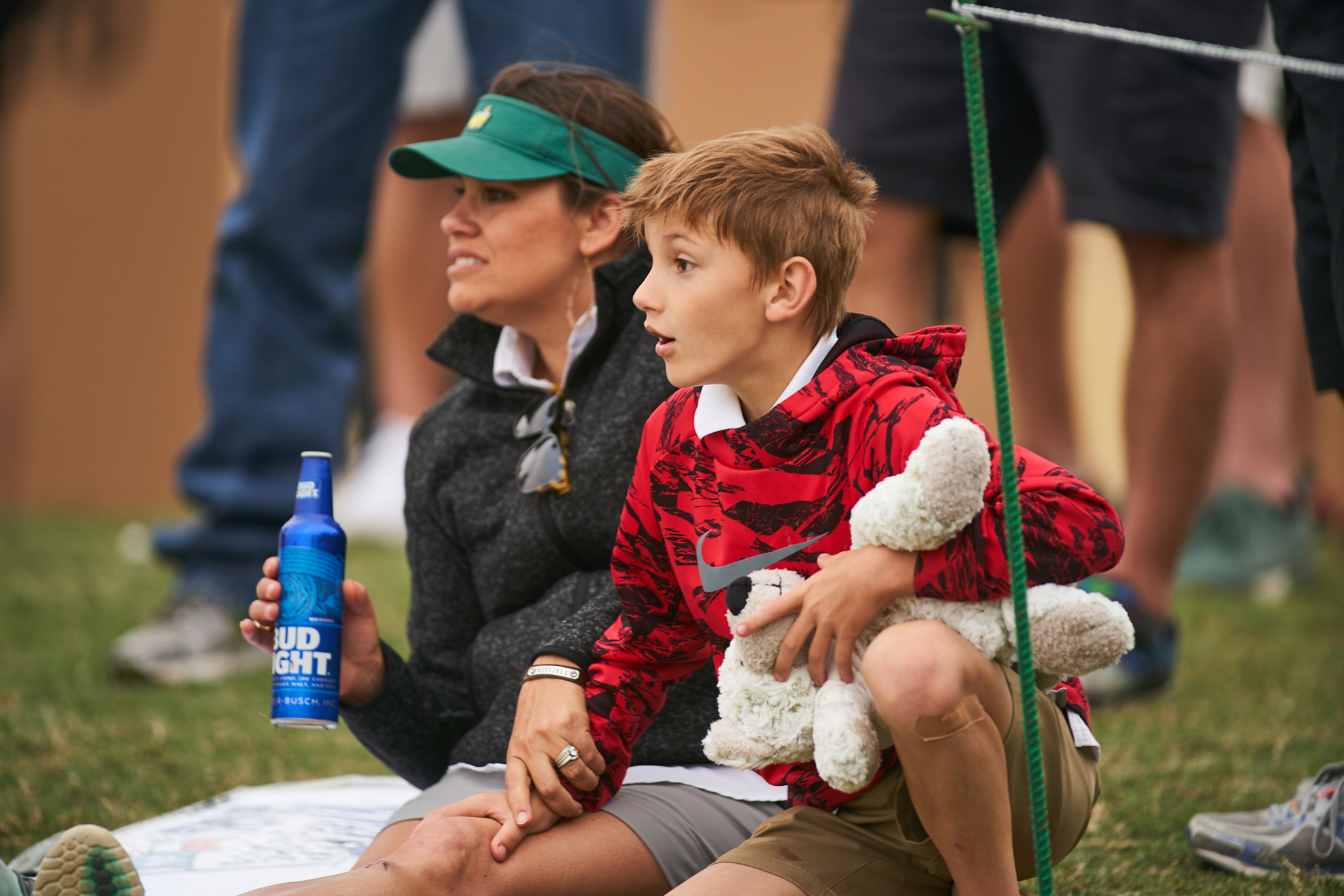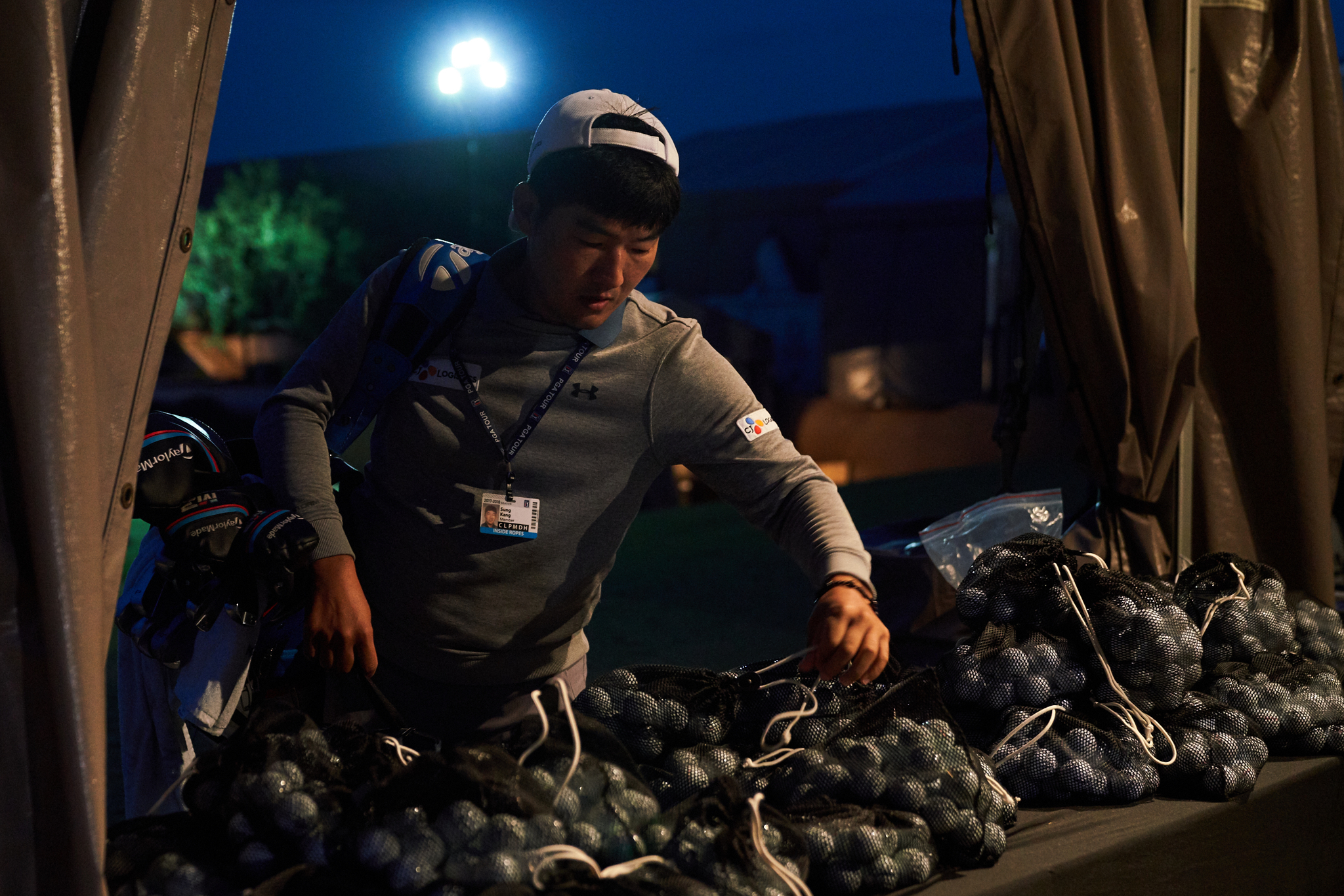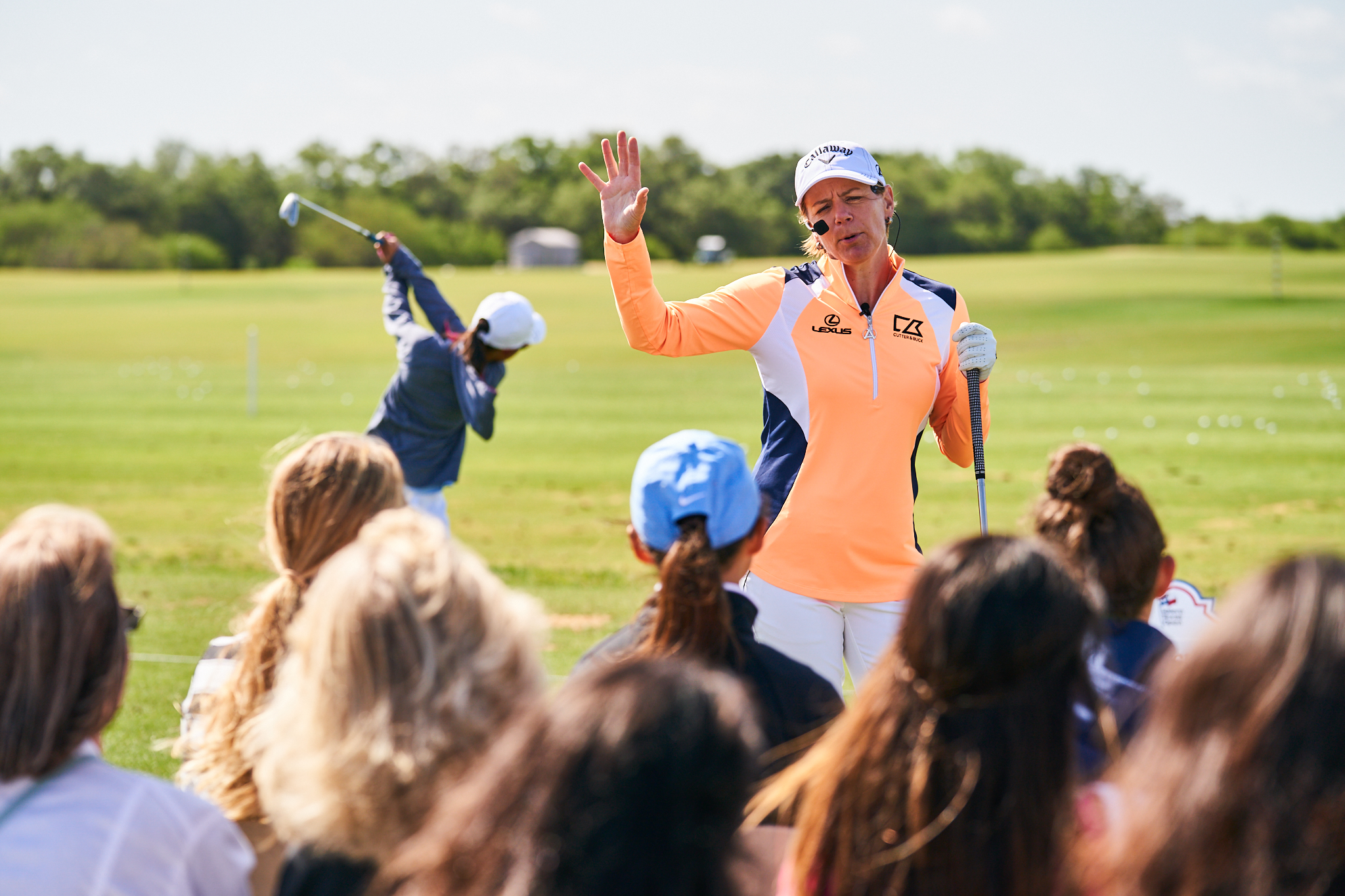2018 Valero Texas Open (or, Don't be that guy in the green hat)

There's a lot more to shooting a golf tournament as a tournament photographer than there is to "just" covering a golf tournament, and it's that very difference that makes my experience at the Valero Texas Open so great.
Rather than concentrate solely on the more public-facing elements of daily competition, as I normally would on an editorial assignment, I'm tasked with working from the inside of the process out. It’s about shooting the pro-ams, the dinners, the cocktail parties, the sponsor tents, the clinics and the luncheons. It’s about documenting the event as a whole, and trying to tell a story that gives a unique insight into the nature of the event that you just don’t get from four days of covering the pros teeing it up. They may not all necessarily be the kinds of photos that wind up in a portfolio, but they’re the kinds of images that are absolutely necessary for the sponsors, the participants, the marketing team, and the people who contribute so much time, money, and effort into putting on a successful event.
I've been fortunate enough to do this for the past four years now, and every year brings a new, more increased (if that's possible) appreciation of what it takes to actually put one of these things on. So many moving parts, so many things that have to go exactly right, and, more than anything, so many talented and dedicated people that have to work together to ensure the success of the event.
My partner in crime for the week, and the guy responsible for bringing me into the fold and making me a part of this great team of people, is Mike O’Bryon, whose name you ought to recognize from his years of golf coverage for Sports Illustrated and, before that, the Miami Herald. Mike has a knack for getting out amongst the crowds and making pictures of people— kids, grown ups, guys in golf shirts along the rope line and frat boys in the beer garden, and showing off what a good time can be had at the tournament. Four years ago, much of that kind of work was way outside of my wheelhouse. But I’ve been learning as the years progress. Still, my main job, once the weekend comes, is to concentrate on the competition. The last day especially, since that’s when it all comes together—the entire year of work by the staff, and four days of golf by the players, all wraps up with the ultimate goal of crowning a champion on Sunday afternoon.
2018 Valero Texas Open champion Andrew Landry tries on his new pair of boots. Sony A7rIII, Sony 24-70mm f2.8 GM
Landry celebrates his win at the 18th green. Sony A7rIII, Sony 70-200mm f2.8 GM
I'm going to post a bunch of my favorites from the week down below, eventually... But first, speaking of Sunday, I hope you can indulge a not-too-brief tangent on golf photography, professionalism, and some possible pitfalls to look out for. In other words, let me tell you a story about the sixth tee, and why you, dear golf photographer, don’t want to be the guy in the green hat.
The sixth tee is just about the only place on the property at TPC San Antonio where you can get the classic, cover-your-ass “top half” shot of a player—you know, something like this: Follow through, club head, player’s face, reasonably back-lit so there are no shadows on the face to worry about, and, if you get down low enough, a clean, nondescript background.
Getting the top-half shot in the bag at the sixth tee. Sony A9, Canon EF 400mm f2.8L-II
It’s my go-to spot early in the final round, and I’ll hang around there and get the last two or three groups coming through just to make sure that I have a picture of the eventual winner in my pocket. And so I did, settling in for the last couple of threesomes, getting the needed frames, and waiting for the final group of the day. Zach Johnson, Andrew Landry, and Trey Mullinax sauntered up to the tee, and along with them came a group of photographers who, understandably, had been following the guy—Landry—who had what was now a 3-shot lead.
Zach Johnson, however, was just a couple strokes back at that point. If you pair the inexperience of a young leader without a PGA Tour win against the experience of a two-time major winner and Ryder Cupper, and couple that with the pucker factor of a final round pressure-cooker, Zach was anything but out of it. In fact, I'd wager that at the point, walking to the tee, despite the fact that he was behind at the time, Zach was the guy to beat. As he teed up his ball on 6, he had a legitimate shot at winning this thing.
Zach began his pre-shot routine like he always does, standing behind the ball, staring down the fairway, lifting his club off the ground, and then slowly walking forward, approaching the ball
And then… a click.
It came from right behind me, Zach heard it, grimaced almost imperceptibly, and backed off. He started his pre-shot routine again.
Behind the ball. Stare down fairway. Approach ball. Take a quick, loose practice swing.
And it’s here that Zach does something most other golfers don’t do, and it can really mess a photographer up if they’re not ready for it. Because when you can't see the ball in the frame, all you have to go on to decide when to start shooting is the golfer's physical actions--the hip turn, the location of his hands, etc. So when you're anticipating your shot, you're going off of what the golfer is doing. And if the golfer looks like he's really about to hit the ball, well, you are then getting ready to shoot, and just like when the golfer is physically committed and starting the process of the swing, so are you committed to the shot in terms of timing and process. Have a look at the next two pictures and see if you can tell which one is a practice swing, and which one is the real thing.
This is just a practice swing, and it looks absolutely no different...
...from Zach Johnson's real swing. Sony A9, Canon EF 400mm f2.8L-II
Zach Johnson does this, and he does it before every single shot. He’ll slide up to the ball, take his stance, waggle a little, and settle in. If you are looking at him from head to toe, you’ll notice that he hasn’t really addressed the ball yet, and that his club is about 6 inches to the side of the ball at this point. If you’re looking at him from the waist up through a long lens though, and you can’t see the ball or his club head, well, you’d swear he was ready to hit. He’ll re-wrap his fingers around the club, his face will tighten up a bit, his shoulders will shift a little, and then he’ll take the club back, starting one last practice swing, except the look of concentration on his face and the speed of the club as it goes back and up tells you—despite everything you should know be true if you’ve observed his routine in the past—that it’s the real thing, and he’ll reach the top and start the club head forward and the hips will start turn just as powerfully as if he were really about to—
Click click click. From behind me again.
It wasn't "early"--whoever was behind me didn't fire at the top of the backswing (and before you roast me for the pictures above, note that they were taken with a Sony A9, a completely silent, mirrorless camera, and that as such it didn't--it couldn't--disturb the golfer in any way. In fact, had Zach heard me at this point, given what you're going to read below, I think it's safe to say I might not be sitting here in any physical condition to write this). But it was during his "pre-shot" routine. Now, some guys handle it differently--a guy named Stephen Ames had a similar practice swing routine and he would joke with photographers all the time ("Okay, who's the rookie?" he used to say) when it happened, but with Zach, on a Sunday afternoon, with a real chance at the lead, that's a big no-no.
So when he heard the shutter burst and came half-heartedly out of the practice swing, Zach threw his head back, yelled “SERIOUSLY???” at no one in particular, and only then turned to look. Right past me. Over my right shoulder.
I heard a meek “Sorry…” from that general direction. Zach was having none of it.
He was fuming. Even with his eyes hidden behind the wrap-around shades, you could tell he was shooting darts at the guy. This was not good—for any of us. He took a couple of seconds to compose himself, re-teed his ball, and went through his entire pre-shot routine again (this time without incident).
And then he blasted his tee shot way out to the right, where it landed behind a tree (and, although he didn’t know it yet, would give him no option but to pitch out sideways into the fairway).
This was definitely not good.
The outcome of that eventual tee shot. Sony A7rIII, Sony70-200mm f2.8 GM
The next voice I heard was that of his caddie, Damon Green (no slouch of a golfer himself, by the way), yelling to a course marshal: “It’s that guy in the green hat. He’s been doing this to us all day.”
I turned around, and that guy in the green hat was already on his way down the rope line, headed toward the fairway.
Now, I don’t really know Zach at all; our paths have crossed here and there but never to the point of a real conversation, but I’ve heard—and have no reason to doubt—that he’s one of the nicest guys on tour. He also always seems to have a tunnel vision that keeps him staring straight ahead, and rivets his head squarely in the game. I mean, you don’t win an Open Championship and a Masters (not to mention 12 PGA Tour titles) by being unfocused and letting stuff rattle you. So when I saw him abandon his normal easygoing gait and storm past me, and then call out to that guy in the green hat, and, upon getting his full attention, give him a well-deserved dressing-down unlike any I’d heard from a tour pro in a long time (although, to his credit, not only was there not a single profanity uttered but he he did start out by saying, “Look, I know we’re all going to make mistakes but…”), I knew that a) not only was he pissed, and b) not only was his concentration broken, but c) there had to be more to it than what had just happened. It turns out there was.
So I asked a couple of other photographers who’d been with the group earlier if anything else had happened.
One told me the story of an earlier hole, where Mr. Green Hat had positioned himself directly in Zach’s putting line, only to get up and move right when Zach was over his ball, ready to putt.
Another told me the story of the previous green, where Mr. Green Hat decided he needed to shoot something/someone other than Zach putting, and therefore had no idea Zach was over his ball and about to putt (again) as he clicked away at whatever else he was looking at.
That’s (at least) four incidents in less than six holes. I’d be pissed, too.
Zach would go on to make bogey on the hole; couple that with how rattled he appeared and I’m guessing any chance he had of catching the leader pretty much ended then and there.
And I guess that’s what infuriated me more than anything about what Mr. Green Hat did. Not that he made a mistake—as even Zach said, we all do. Okay, so he made four of them in a six-hole span, too, but let he who is without sin and all that…This mistake, however, was the latest in a line of them, and in making it, it’s pretty safe to say that he directly affected the outcome of the tournament. We can (rightly) expect a tour player to be able to focus and work through one mistake or distraction as a one-off event, but when one person—be it a spectator, a photographer, whoever—is consistently doing things that chip away at a player’s concentration to the point where even the most stoic of them loses the ability to concentrate, that’s a big problem for everyone.
And it sucked even more that it was a photographer who was responsible. I wanted to apologize. But for what? For some guy I’d never seen before who obviously didn’t know what he was doing, making the rest of us look bad? I like to think that most of the tour pros don’t paint with that broad a brush, but nevertheless, it just plain sucked to have to be out there for that.
But let’s take this as a learning opportunity, I guess. At the risk of sounding pedantic, Mr. Green Hat blew through 3 key rules for photographing competitive golf:
1. Know the game. Golf has a lot of do’s and dont’s, some of them arcane and sure, it can take some getting used to. But let’s face it, keeping quiet, not shooting when you could be disturbing a player’s concentration, and not making any sudden movements while play is actually happening are some pretty obvious ones. Keeping out of a player’s direct line of vision would be another.
2. Know the situation. A lack of situational awareness is probably the thing that gets photographers in trouble more than anything else out on a golf course. Shooting something away from the ball and not knowing someone else is hitting. Talking with a friend or colleague without realizing how close you are to a tee or fairway. Not keeping an eye out for a ball in the rough as you proceed to your next shot. Keep your head in the game.
3. Know your player. Different players have little idiosyncrasies, and learning what they are can prevent something like what happened on the tee box. I’m not talking about things that you can’t know until you’ve found out the hard way—like that Jordan Spieth and Christie Kerr can’t stand it when photographers shoot while they’re lining up a putt (which is absolutely permissible)--but about things you can observe and learn from. Sure, Mr. Green Hat may have never covered golf before, or maybe he’d just never covered Zach Johnson before—but by the 6th tee, Zach would have had the opportunity to take at least 8 full-swing shots, utilizing his regular, if tricky, pre-shot routine. That’s plenty of opportunity to observe and learn what to expect.
Of course, all of this 6th tee business would be a moot point if he’d been using a (shameless plug alert) silent camera like, say, a Sony A9. But he wasn’t. Oh well. Lesson learned.
We hope.
And so we move on to some pictures from the week...
Jimmy Walker blasts out of a bunker near the 11th green. Sony A9, Canon EF 400mm f2.8L-II
Heading home after a practice session. Sony A9, Canon EF 400mm f2.8L-II
Talor Gooch, 6th tee. Sony A9, Canon FD 500mm f8 Reflex SSC
16th green. Sony A9, Canon EF 400mm f2.8L-II
Saturday (yes, Saturday) Pro-Am. Sony A9, Sony 70-200mm f2.8 GM
Martin Laird, 10th fairway. Sony A7rIII, Sony70-200mm f2.8 GM
Landry lines up a putt at 18 on Sunday. Sony A7rIII, Sony70-200mm f2.8 GM
Sipping a whiskey at an 18th green skybox Sony A7rIII, Sony 24-70mm f2.8 GM
David Feherty once described Jim Furyk's swing as "a one-armed man trying to wrestle a snake in a phone booth." Now you know why. Sony A7rIII, Sony 24-70mm f2.8 GM
Jhonattan Vegas, 10th fairway . Sony A7rIII, Sony 70-200mm f2.8 GM
Practice green with the JW Marriott San Antonio Hill Country in the background, pre-dawn. Sony A7rIII, Sony 24-70mm f2.8 GM
Kang Sung-hoon grabs some practice balls at the range early Friday morning. Sony A7rIII, Sony 24-70mm f2.8 GM
Friday morning dawn patrol. Sony A7rIII, Sony 24-70mm f2.8 GM
Volunteers sort and bag the various types of practice balls by hand at the range. Sony A7rIII, Sony 24-70mm f2.8 GM
Annika Sorenstam gives a clinic on the range during Executive Women's Day on Tuesday.. Sony A7rIII, Sony 24-70mm f2.8 GM
So some of the operations team adopted a baby goat, and it became the tournament's unofficial mascot. It showed up everywhere... Sony A7rIII, Sony 24-70mm f2.8 GM
16th tee box. Sony A7rIII, Sony 24-70mm f2.8 GM




























